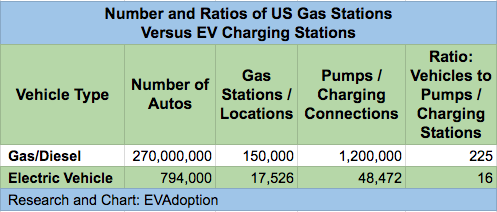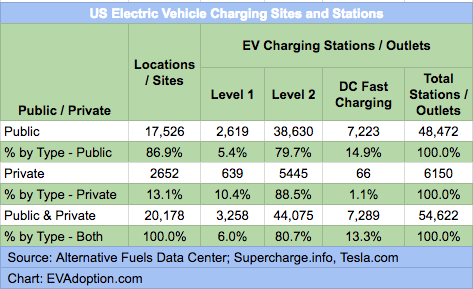Almost every article in the mainstream American press about the state of electric vehicle (EV) adoption will include a comparison of the number of gas stations to the number of EV charging stations. The numbers used are usually something like 150,000 gas stations compared to less than 50,000 charging stations.
The comparison is idiotic which I will go into in detail in an upcoming CleanTechnica article. I wish the comparison would stop.
EVs comprise only 0.29% of the number of autos on the roads in the US today. Why should the number of EV charging stations be compared to this much larger stock of vehicles which is 340 times larger than the number of EVs? Rather, assessing the current stock of EV charging stations should be similarly based on the number of existing EVs.
Which is what I’ve analyzed.
Ratio of EVs to EV Charging Stations is 14 Times Better Than Auto to Gas Station Ratio
In the US today there are approximately 270 million automobiles and an estimated 150,000 gas stations. While I could not find any reliable numbers to support this, I’m using an estimate that an average of 8 pumps are available at any given time for concurrent refueling at a typical modern gas station. Dividing 270 million autos by 1,200,000 pumps = a ratio of 225 autos per available pump.
There are roughly 794,000 EVs in the US as of this writing and 48,472 public charging stations (individual connections) by my analysis. This does not include residential or private charging stations.
Doing the math, this means that there is a ratio of 16 EVs to 1 charging station. This means that with the current stock of EVs in the US, there are actually 14 times more charging stations per EV than available gas pumps per auto.
If we assume that 75% of current EV owners have a charging station at home, then there are another 595,500 charging stations in the US, for a total of roughly 644,500 charging stations. At that level the ratio of EVs to charging stations would be 1.23 to 1.
Gas stations simply don’t come close to matching the ratio of EVs to EV charging stations.





11 Responses
Try to get from Budd Lake, NJ to Akron, OH in an EV in less than 2 or 3 days along Route 80, only the most major highway in the US.
There are 8 Tesla superchargers along the 405 mile I-80 route from Akron Ohio to Budd lake NJ. A Tesla model S LR can manage that run with a 5 min stop at any one of the 8 chargers. The lowest range Model 3 can complete the same drive with three 15 min stops for a total trip time of 7 hours 18 min only 45 min longer than what ever inferior combustion engine vehicle you drive.
How about taking a scenic drive to Yellowstone and back?
The article on relative numbers of stations (refueling versus charging) completely leaves out the fact that with a portable EVSE (and just about every EV comes with at least a Level 1 EVSE, sometimes called a “trickle charger”), an EV can charge just about anywhere because electricity is everywhere. This is called “informal charging”. I do this every day at home (although I put in a NEMA 14-30 outlet so I can use a Level 2 EVSE). With a good extension cord, and the permission of the property owner, EV owners can charge at just about every home or business or RV park. This means that there are likely thousands of places capable of informal charging for every EV currently on the road in America. Realizing this, the lack of formal charging stations is likely only an issue for long distance travelers who would like a quick charge, which is a minority of drivers.
Pump is Fueling a vehicle in 3 minutes to drive 700Km
Level 2 Charger requires 5 hours to charge a battery for 300Km
Doing the Math – about 200 level 2 chargers are equal to 1 fueling pump.
With the country moving more and more electric in transportation, I was interested in the pros and cons of gas vs electric. I even considered which would be more sustainable to operate in business. I have property in an awesome location for both.
Would some EV owner tell me about driving from LA or NY to Yellowstone and spending three days in Yellowstone and back to home. Please use something other then a Tesla. For example a ford EV. Maybe a Chevy Bolt.
There are some serious problems with this analysis. The main block to widespread EV adoption is what they call “range anxiety”. Most people will (slow) charge their EVs at home overnight, great. But if EVs are to replace ALL gas powered surface vehicles, it means there needs to be a public infrastructure more or less equal to the gas-station retail industry in this country. You cannot sell EVs to people who need to be able to go to the full range of the car, charge up fast, then head back. You are not gonna sells cars to these people if you cannot go anywhere that gas stations are currently available, and fast charge your new EV. There are now only 4398 universal fast DC stations in the US. This number does not include Tesla stations, because Tesla has its own proprietary charging infrastructure that does not serve other makes, of which there will be many. Most of its fast stations are in California anyway. Since there are about 115,000 gas stations in the US (your number of 150,000 is a bit high), this ratio is 26:1. Your article argues that whatever the current number of EV charging stations is, it is adequate now, which may be the case. But we want to bring about a complete swap of ICE for EV vehicles, don’t we? In that case, we are going to need to get the 115,000 gas stations swapped over to EV stations, or else build about 110,000 new EV stations in the US to make it possible to go anywhere with the same refueling abilities as a gas car or truck. Biden’s infrastucture bill contains $7.5B for that, so let’s hope that helps close the gap. But there is no way that 4300 fast charging stations is enough, as it is now.